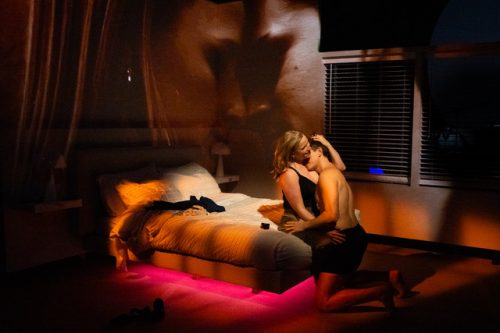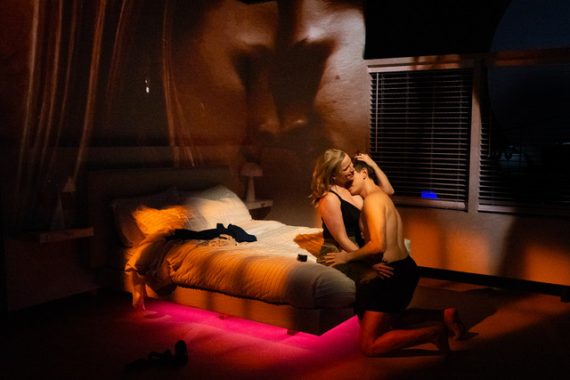 United States Daniel Schlosberg, The Extinctionist: Suliman Tekalli (violin, viola), Taylor Levine (guitar), Katherine Fortunato (percussion) / Daniel Schlosberg (pianist, conductor). Baruch Performing Arts Center, New York, 10.4.2024. (RP)
United States Daniel Schlosberg, The Extinctionist: Suliman Tekalli (violin, viola), Taylor Levine (guitar), Katherine Fortunato (percussion) / Daniel Schlosberg (pianist, conductor). Baruch Performing Arts Center, New York, 10.4.2024. (RP)

Production:
Libretto – Amanda Quaid
Director – Shadi Ghaheri
Sets – Kate Noll
Costumes – Haydee Zelideth
Lighting – Reza Behjat
Projection – Camilla Tassi
Props – Madisen Frazier
Puppetry – Afsaneh Ayani
Dramaturg – Peregrine Teng Heard
Cast:
Woman – Katherine Henly
Man – Philip Stoddard
Friend / Puppeteer – Claire Leyden
Doctor – Eliam Ramos
Since it was founded in 2016, Heartbeat Opera has presented reimagined stagings of classic operas that speak to our times. This season, it is presenting the world premiere of an opera, Daniel Schlosberg’s The Extinctionist – a first for this daring, innovative company.
Schlosberg is known for crafting arrangements of operas ranging from Purcell’s Dido and Aeneas to Verdi’s Macbeth which have garnered critical acclaim and often resulted in sold-out houses as well. The casts he had available were small, usually no more than a few players, but the results were always ingenious and often stunning.
As an arranger, Schlosberg has an uncanny ability to discern the musical gist of an opera and express it in a panoply of sounds as authentic as they are imaginative. He achieves the same alchemy in The Extinctionist with just four players, producing music that is scintillating, transparent and often excruciatingly beautiful. Even more important, the music he composed is always at one with the provocative and heartbreaking story of The Extinctionist. It is the tale of a woman who decides that the best way to protect the future of our endangered planet is to jettison her dream, as well as that of her husband, to have a child. It is also a tale of betrayal, which is depicted with an honesty that is as unflinching as it is unforgiving, and painful to witness.
Amanda Quaid wrote the libretto for The Extinctionist, which she adapted from her play of the same name. It is the story of a young married couple who are having trouble conceiving a child. When her childhood friend tells the Woman that she is pregnant, it pierces her to the core. As girls, they dreamed of being pregnant together and having their babies at the same time. The distraught Woman can only pay lip service to her friend’s joy.
Frustration and sorrow over her failure to become pregnant give way to the Woman’s growing conviction that bringing a child into the world in the present day is wrong. She unilaterally decides to take steps to prevent that from ever occurring. The Doctor whom she consults is less than enthusiastic about performing the procedure and asks if she has discussed the matter with her husband. She has not, but the suggestion that he use a condom during sex delivers the message. He is confused and hurt but resigned to her decision. Whether or not to have a baby is out of her control, however, for prior to the operation the doctor informs her that she is infertile. Her husband, friend and doctor form a Greek chorus who comment on her fate. No one emerges unscathed or heroic at the end of this opera.
Shadi Ghaheri’s concept for The Extinctionist is as uncompromising as the story. She drew complex, nuanced characterizations from the four members of the cast. There was no sugar coating of the emotions that motivate the Woman, or any of the other characters. Nor did Ghaheri shy away from depicting the clinical details of being examined for surgery: the sight of the Woman with her feet in stirrups as the Doctor examined her prompted gasps from some in the audience. This was a real story that hit home and transcended generational divides.

Kate Noll’s sets were simple, but they effectively delineated the Woman’s dilemma. A modern white bedroom where the couple made love became where love and hope died. Lighting and projections amplified the Woman’s mental state and revealed both the beauty of nature and man’s impact on the environment.
The Woman’s decision did not come easily. She was tormented by visions of the daughter she would never have. The girl was depicted in childhood and adolescence by a puppet. It is not a particularly innovative touch, but it delivered an emotional punch nonetheless.
Soprano Katherine Henly gave a towering performance as the Woman. The role is as demanding as any in the repertoire with a wide-ranging tessitura and constant emotional and vocal hairpin turns. Once minute, Henly sang bursts of coloratura that were the vocal equivalent of a panic attack and, in the next, she blazed when expressing her fears and, later, her defiance. It was, however, the sound of Henly’s voice when she was singing as softly as imaginable that pierced the soul. The integrity and emotional honesty that she brought to this difficult role were impressive.
As the Man, baritone Philip Stoddard painted his character in more subtle shades vocally and dramatically. He was a lusty lover in the opening scenes and confident that the fertility issues would be overcome. Adoption was an option for him. However, he could not accept what he perceived as his wife’s betrayal of their marital compact, and his voice, like the character, became emboldened with confusion and anger.
Claire Leyden, the Friend, appeared on stage as a vision of joy and delight. The Woman deftly broke this bubble of joy, and the Friend’s demeanor acquired an edge, as did her beautiful crystalline soprano. Leyden also worked magic as the Puppeteer who brought the little girl of the woman’s imagination to life. Eliam Ramos brought complexity to the challenging and unsympathetic role of the Doctor. He exuded an unsettling mix of avuncular charm and smooth masculine insensitivity, which even the warmth of his rich bass-baritone could not quite dispel.
Schlosberg’s music leaned towards minimalism, but with a depth and dimension created not only through his orchestrations but also electronic means. He is nothing if not eclectic. Taylor Levine even took a solo turn on the electric guitar, in a contemporary spin on the ‘Meditation’ for solo violin from Massenet’s Thaïs. And this listener, for one, heard strains of the theme from the 1970s romantic film Love Story. Its melody was heard as Stoddard sang of his love for his wife, as well as his despair over the choice she thought she alone could make.
Rick Perdian
